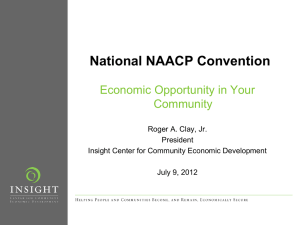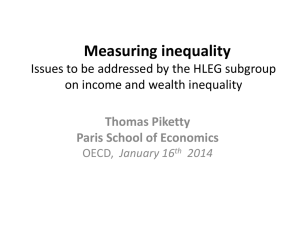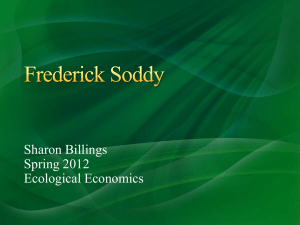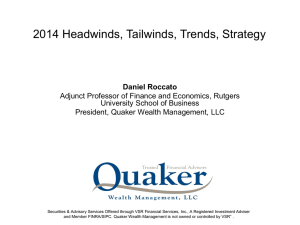The Constitution Chapter 2 PowerPoint
advertisement
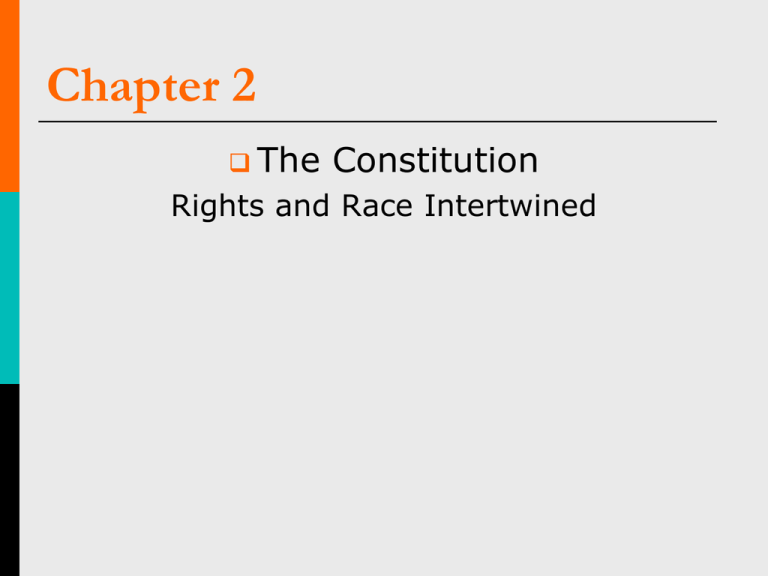
Chapter 2 The Constitution Rights and Race Intertwined Chapter 2: Measuring Equality Whom Did the Framers Represent? Characteristics of the Fifty-Five Framers[1] White 100% (55) Male 100% (55) Education University educated 56.4% (31) Institutions attended: Princeton (10) Univ. of Pennsylvania (2) Columbia College (2) William & Mary (3) Harvard (3) Scottish universities (3) Yale (4) Middle & Inner Temple, London (6) Occupation Lawyer (only) 47.3% (26) Lawyer & another profession 16.3% (9) Government experience Colonial/Military Official 94.5% (52) Member of Continental Congress 74.5% (41) Property ownership Owned their residences 100% (55) Owned lands used for farming 56.4% (31) Owned slaves 31 % (17) p. 40 Chapter 2: Measuring Equality Whom Did the Framers Represent? Cont. Economic level[2] Wealthy class/comfortable Middle Poverty-level 10.9% (6) 76.3% (42) 12.7% (7) Characteristics of the General Population according to the 1790 Census[3] Race White 80.40% (3,140,531) Slave Blacks 17.83% (694,207) Free Blacks 1.52% (59,196) Gender (White Population Only) Males 50.92% (1,599,213) Females 49.08% (1,541,318) Education level[4] “Most” White male children in the North attended school for 4-6 months a year from age 4 to 14. “Substantial amount” of White male children in the South attended school for 4-6 months a year from age 4-14. “Few” White male children in the West attended school or were literate. “Very few” White male children attended college or university. [5] “Very few” White female children received any formal classroom instruction Chapter 2: Measuring Equality Whom Did the Framers Represent? Cont. Significant Colonial Occupations[6] Farmer Lumbering Fishing Iron-mining Trading in furs and skins Production of naval stores Property Ownership White slave-owning families 11.6% (47,664) Land owners: 13% of (1774 population) People associated with slave owning: 7.2% (of White population in 1790); 6.13% (in 1774) Economic level (in 1774)(category classifications were determined from the distribution of wealth)[7] High wealth: Top 2% held 24.6% of the wealth Middle wealth: Top 20% held 73.2% of the wealth Low wealth: 70% held only 28.6% of the wealth Very low wealth: Botton 10% owned 1.7% of the wealth (in other words they were in debt) No Wealth: 81.53% of the population had no measurable wealth Chapter 2: Measuring Equality Whom Did the Framers Represent? Cont. [1] The U.S. Constitution: The Delegates. National Archives and Records Administration, http://www.gov/exhall/charters/constitution/confath.html; Forrest McDonald, We the People: The Economic Origins of the Constitution (Chicago: The University of Chicago Press, 1958), Chapters 1-3. [2]Information on economic levels were drawn from the Biographical Index of Our Founding Fathers, The National Archives and Record Administration, Washington, D.C. The category classifications were determined from language in the biographies. Actual dollar figures of wealth and income are not readily available. [3]Unless otherwise indicated data are taken from the 1790 Census that surveyed population characteristics mainly. [4]Carl F. Kaestle, Pillars of the Republic (New York: Hill and Wang, 1983); Genealogical Publishing Company, A Century of Population Growth (Baltimore: GPC, 1989). [5]The 1790 Census indicated that there were 807,312 white males over the age of 16 in the country. A listing of the most prominent colleges and universities at the same time show a combined enrollment of 1,122 students (white males). [6]Stella H. Sutherland, Population Distribution in Colonial America (New York: Columbia University Press, 1936), pg. xi. [7]Jones, Alice Hanson, Wealth of a Nation to Be (New York: Columbia University Press, 1980); Jones, Alice Hanson, American Colonial Wealth (New York: Arno Press, 1977.) Chapter 2: Evaluating Equality p. 44 p. 49





